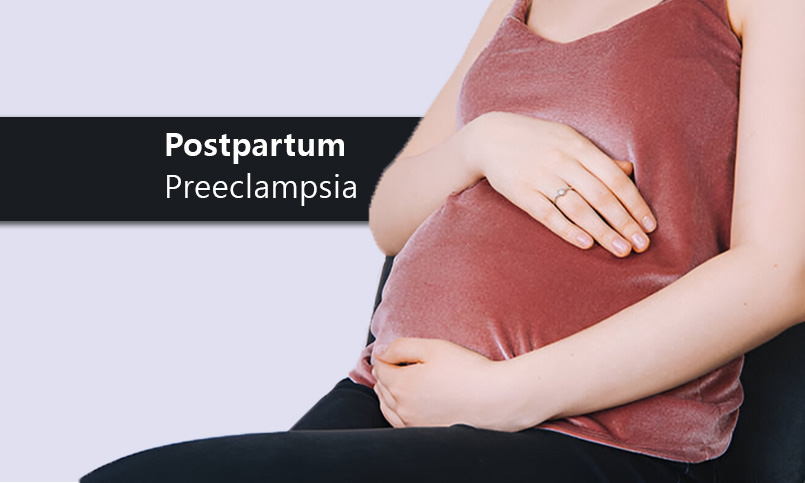Postpartum preeclampsia is a serious medical condition that can occur after giving birth. It is a complication that often goes unnoticed or misunderstood, yet it poses significant risks to both the mother and the newborn. In this comprehensive guide, we will delve into the intricacies of postpartum preeclampsia, exploring its causes, postpartum preeclampsia symptoms, diagnosis, and management strategies.
Understanding Postpartum Preeclampsia
Postpartum preeclampsia is a continuation or development of preeclampsia after the baby is delivered. Preeclampsia is a condition characterized by high blood pressure and the presence of protein in the urine. While most cases of preeclampsia resolve after delivery, some women may experience a resurgence or new onset of symptoms in the postpartum period.

Incidence and Risk Factors
According to medical research, postpartum preeclampsia affects approximately 1 in 600 pregnancies. Several risk factors increase a woman’s chances of developing this condition, including:
- Previous history of preeclampsia or gestational hypertension
- Preexisting medical conditions such as chronic hypertension, diabetes, or kidney disease
- Multiple pregnancies (twins, triplets, etc.)
- Obesity
- Advanced maternal age
Also Read Blog: What is Listeria in Pregnancy?
Symptoms and Signs
The symptoms of postpartum can be subtle and easily overlooked. New mothers must be vigilant and report any concerning signs to their healthcare provider immediately. Common symptoms may include:
- Severe headache that doesn’t go away
- Visual disturbances (blurred vision, light sensitivity)
- Abdominal pain or epigastric pain
- Nausea and vomiting
- Swelling in the face, hands, or feet
- Shortness of breath
Severe symptoms, such as seizures or altered mental status, may indicate a life-threatening condition called eclampsia, which requires immediate medical attention.

Diagnosis of Postpartum Preeclampsia
Diagnosing postpartum involves a combination of physical examinations, blood pressure monitoring, and laboratory tests. Healthcare providers will:
- Measure blood pressure regularly
- Check for protein in the urine (proteinuria)
- Monitor liver and kidney function through blood tests
- Assess for signs of organ damage or complications
Early detection and prompt treatment are crucial for managing postpartum preeclampsia and preventing further complications.

Management and Treatment Options
The primary goal of treatment is to stabilize the mother’s condition and prevent potential complications. Treatment options may include:
- Antihypertensive medications: These medications help control high blood pressure.
- Magnesium sulfate: This medication is used to prevent seizures in cases of severe preeclampsia or eclampsia.
- Corticosteroids: These may be prescribed to improve liver and kidney function.
- Fluid management: Intravenous fluids may be administered to maintain proper hydration and electrolyte balance.
In severe cases, hospitalization or delivery (if the baby hasn’t been born yet) may be necessary to ensure the safety of both the mother and the baby.
Prevention and Early Detection
Preventive measures for postpartum preeclampsia include:
- Regular prenatal care: Attend all scheduled prenatal appointments to monitor for signs of preeclampsia during pregnancy.
- Postpartum follow-up: Attend all postpartum check-ups to monitor for symptoms and signs of postpartum preeclampsia.
- Patient education: Learn about the risk factors, symptoms, and importance of seeking prompt medical attention.

Causes and Risk Factors
While the exact cause of postpartum preeclampsia is not fully understood, several factors are believed to contribute to its development:
Pathophysiology
- Abnormal placental development: Preeclampsia is thought to be caused by a problem with the placenta, which can lead to reduced blood flow and oxygen supply to the fetus.
- Endothelial dysfunction: The lining of blood vessels (endothelium) becomes damaged, leading to inflammation and narrowing of blood vessels.
- Genetic and environmental factors: Certain genetic variations and environmental exposures may increase the risk of developing preeclampsia.
Preexisting Conditions
- Chronic hypertension: Women with high blood pressure before pregnancy are at a higher risk of developing preeclampsia.
- Diabetes: Both type 1 and type 2 diabetes can increase the risk of preeclampsia and postpartum preeclampsia.
- Autoimmune disorders: Conditions like lupus or antiphospholipid antibody syndrome can contribute to the development of preeclampsia.
Pregnancy-Related Factors
- Multiple gestation: Being pregnant with twins, triplets, or more increases the risk of preeclampsia and postpartum preeclampsia.
- Obesity: Women with a body mass index (BMI) of 30 or higher are at a higher risk of developing preeclampsia.
- Advanced maternal age: Older mothers (over 35 years) have a slightly increased risk of preeclampsia.
It’s important to note that while these factors can increase the risk, postpartum preeclampsia can still occur in women without any obvious risk factors.
Complications and Risks
Postpartum preeclampsia can lead to serious complications for both the mother and the newborn if left untreated. Some potential complications include:
Maternal Complications
- Eclampsia: This life-threatening condition is characterized by seizures and can lead to coma or death if not treated promptly.
- HELLP syndrome: A severe form of preeclampsia that involves hemolysis (breakdown of red blood cells), elevated liver enzymes, and low platelet count.
- Pulmonary edema: Fluid accumulation in the lungs, which can cause shortness of breath and respiratory distress.
- Stroke: Increased risk of stroke due to high blood pressure and vascular complications.
- Organ damage: Preeclampsia can lead to damage to the liver, kidneys, and other vital organs.
Risks to Newborn
- Preterm birth: Severe cases of preeclampsia may require early delivery, which can lead to complications associated with prematurity.
- Low birth weight: Preeclampsia can restrict fetal growth, resulting in a lower birth weight.
- Respiratory distress: Newborns may experience breathing difficulties due to complications from preeclampsia.
It’s crucial to seek prompt medical attention if any concerning symptoms arise, as early treatment can help prevent or manage these potentially life-threatening complications.

Long-Term Health Considerations
While postpartum preeclampsia is a temporary condition, it can have long-lasting effects on a woman’s health. Regular follow-up care and lifestyle modifications are essential to minimize these risks:
- Increased risk of cardiovascular disease: Women who have had preeclampsia or postpartum preeclampsia have an increased risk of developing heart disease, stroke, and high blood pressure later in life.
- Kidney disease: Preeclampsia can cause damage to the kidneys, increasing the risk of chronic kidney disease in the future.
- Future pregnancy complications: Women who have experienced preeclampsia or postpartum preeclampsia are at a higher risk of developing these conditions again in subsequent pregnancies.
FAQs
How long after delivery can postpartum preeclampsia develop?
Postpartum preeclampsia can develop anytime within the first 6 weeks after delivery, but most cases occur within the first 48 hours to 1 week after giving birth.
Can postpartum preeclampsia occur in women who didn’t have preeclampsia during pregnancy?
Yes, postpartum preeclampsia can develop in women who had no signs of preeclampsia during their pregnancy.
Is postpartum preeclampsia life-threatening?
If left untreated, postpartum preeclampsia can progress to eclampsia, which is a life-threatening condition characterized by seizures and potential organ damage.
What are the long-term effects of postpartum preeclampsia?
Women who have experienced postpartum preeclampsia may have an increased risk of developing cardiovascular disease, kidney disease, or high blood pressure in the future.
Conclusion
Postpartum preeclampsia is a serious condition that requires prompt medical attention. By understanding the symptoms, risk factors, and available treatment options, new mothers and their healthcare providers can work together to ensure a safe and healthy postpartum preeclampsia recovery. Vigilance, early detection, and appropriate management are key to reducing the risks associated with this condition.
Remember, your health and the well-being of your newborn are of utmost importance. If you experience any concerning symptoms after giving birth, do not hesitate to seek medical advice immediately.
